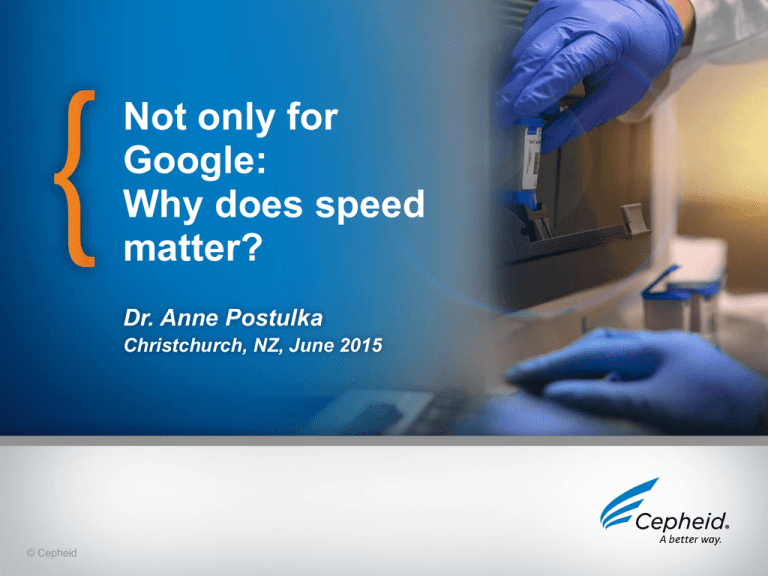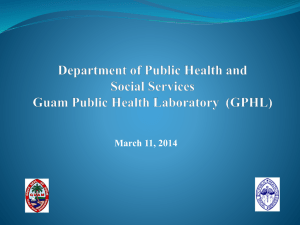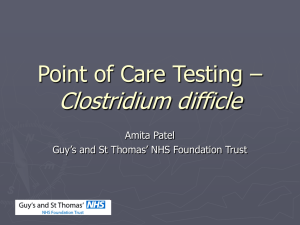3- Not Only for Google. Why Does Speed matter
advertisement

Not only for Google: Why does speed matter? Dr. Anne Postulka Christchurch, NZ, June 2015 1 Cepheid © © Cepheid Who am I and where do I come from? 2 © Cepheid Who else is there? 3 © Cepheid For Google 4 © Cepheid Speed matters – also in MedTech 5 © Cepheid Content • Definition of speed • Objectives of speed • Feasibility of speed • Benefits of speed • What does it take 6 © Cepheid Speed? Let’s talk TAT 11:00 12:00 Assemble Batch Set up Reception 13:00 Run assay 14:00 15:00 16:00 Assemble Batch Set up Run assay TAT: Is it real? 7 © Cepheid 17:00 Samples received after 15:00 processed next working day –> TTR minimum 23h plus transport time Transcribe Reception 10:00 Transcribe 09:00 18:00 What does speed mean – for IVDs? • Speed is TAT, but above all total time-to-result (TTR) Recommended: the DIY pathway (speed) analysis 8 © Cepheid Content • Definition of speed • Objectives of speed • Feasibility of speed • Benefits of speed • What does it take 9 © Cepheid MEDICAL VALUE Reducing TTR = Increasing Medical Value 0 12 hrs 1 day Medical Value: Time to Result is crucial 10 © Cepheid 2 days TIME TO RESULT «Better, sooner, more convenient: Increasing youth friendliness of Family Planning Services in New Zealand » Ms Rose Stewart, National Nursing Advisor, New Zealand 11 © Cepheid Economic and Medical Cost of Delayed Diagnosis EXPENSE Potential Economic Impact • Unnecessary Antibiotics Expense • Isolation Expenses • Blocked Bed Expenses Potential Patient Impact • • • • Delayed or Wrong Diagnosis Misuse or Overuse of Antibiotics Cross-infection Increased Length of Stay CEPHEID PCR 2 HOURS 24 HOURS 48 HOURS 72 HOURS TIME TO TEST RESULT Time to Test Results Costs Money and Lives Articles that look at time to result as crucial to maximizing diagnostic value: 1. Lance R. Peterson, M.D., Donna M. Hacek, M.T. (A.S.C.P.), Ari Robicsek, M.D., Case Study: An MRSA Intervention at Evanston Northwestern Healthcare, printed in The Joint Commission Journal on Quality and Patient Safety Volume 33 Number 12, December 2007 12 © Cepheid 2. Lance R. Peterson, M.D., Rapid Diagnosis of Community-Acquired MRSA, printed in Clinical Updates in Infectious Diseases, Volume Issue 3, October 2008 3. Eli N. Perencevich, MD, MS et al., SHEA Guideline: Raising Standards While Watching the Bottom Line: Making a Business Case for Infection Control, Infection Control and Hospital Epidemiology, Volume 28, Number 10, October 2007 Meet the Needs of Patients and Physicians Short TAT, short TTR, actionable results ‒ Improve access to and value of testing ‒ Avoid disruption of carer-to-patient-interaction ‒ Personalize care (Chris Price, UK) ‒ Patient-centered, outcomes focused medicine 13 © Cepheid Content • Definition of speed • Objectives of speed • Feasibility of speed • Benefits of speed • What does it take 14 © Cepheid Reliable, reproducible results anytime, any place Integrated Platform and Test Insert Swab into Elution Reagent Vial and Break at Score Vortex and Dispense Sample into Port S Insert Cartridge and Start Assay 1 2 3 Total Hands-On Time <1 Minute 15 © Cepheid Random Access 24/7 – the Alternative 09:00 10:00 11:00 12:00 13:00 1 2 3 Modules 4 5 6 7 8 • In 8 hours: 50-100 real-time results • Daily capacity ~250 results with 8 modules used 24/7 16 © Cepheid 14:00 Feasibility of speed = near-patient MRSA Group B Strep Influenza CT/NG C.difficile Norovirus Tuberculosis… 17 © Cepheid Bringing diagnostics closer to patients 18 © Cepheid Content • Definition of speed • Objectives of speed • Feasibility of speed • Benefits of speed • What does it take 19 © Cepheid Medical and Economic Benefits of Speed • Speed = short TTR = timely diagnosis ‒ Does it make a difference for patients? • Where is the evidence? • And hey: What does it cost? 20 © Cepheid Evidence? An example. Introduction of the first random access PCR test for the diagnosis of C.difficile Infection. Objective of project: Answer 2 questions. 1. Do rapid results make a difference for patients (outcomes)? 2. How does the impact translate into costs (or gains) for the hospital? 21 © Cepheid “Cost and Impact on Patient Length of Stay of Rapid Molecular Testing for Clostridium difficile” 1/2 Study design ‒ Prospective interventional study ‒ 2 acute care hospitals in Swansea, Wales, UK ‒ More than 1,000 consecutive patients enrolled from March to Sept. 2011 Results Time to reportable result for Xpert C. difficile was on average 1.53h: ‒ 21h faster than reference method for positive samples ‒ 45h faster for negative samples Length of stay ‒ PCR positive patients were discharged ~4.88 days earlier & ‒ PCR neg. patients ~7.03 days earlier compared to reference method. 22 © Cepheid “Cost and Impact on Patient Length of Stay of Rapid Molecular Testing for Clostridium difficile” 2/2 • Micro-costing results: ‒ Testing cost per sample was £36.18 for PCR, £7.53 for CCNA positive, and £8.78 for CCNA-negative samples • With routine use of real-time PCR on all patients in one year would potentially save 38,247 bed days in ABMUHB. • Cost of extended LOS has been identified as main cost driver in CDI. • Extrapolation: Investing 80 NZD in rapid PCR could provide: ‒ Clinically useful result within 1-2 hours ‒ Reduced LOS ‒ Cost-savings 740 NZD/day; 1,640 NZD per patient • Conclusion (authors) 23 ‒ A rapid molecular test for C. difficile in an acute hospital setting produced quick results that led to a decrease in LOS compared to historic CCNA control patients. This could result in considerable savings through © Cepheid reduced excess inpatient days. 24 © Cepheid Bode, NL and D Lonneke G.M. Bode, M.D., Jan A.J.W. Kluytmans, M.D., Ph.D., Heiman F.L. Wertheim, M.D., Ph.D., Diana Bogaers, I.C.P., Christina M.J.E. Vandenbroucke-Grauls, M.D., Ph.D., Robert Roosendaal, Ph.D., Annet Troelstra, M.D., Ph.D., Adrienne T.A. Box, B.A.Sc., Andreas Voss, M.D., Ph.D., Ingeborg van der Tweel, Ph.D., Alex van Belkum, Ph.D., Henri A. Verbrugh, M.D., Ph.D., and Margreet C. Vos, M.D., Ph.D. Conclusions The number of surgical-site S. aureus infections acquired in the hospital can be reduced by rapid screening and decolonizing of nasal carriers of S. aureus on admission. 25 © Cepheid Bode et al, NEJM: Conclusions • HAI: ‒ “The results of our trial provide solid evidence of the preventive effect of S. aureus decolonization and a good estimate of the size of this effect: the risk of hospital-associated S. aureus infections was reduced by nearly 60% (3,4% vs. 7,7%))”. • LOS: ‒ “The mean duration of hospitalization was significantly shorter in the mupirocin-chlorhexidine group than the placebo group (12.2 vs. 14.0 days)” 26 © Cepheid Benefits of Speed: Summary • The value of rapid results – Is it worth it ‒ Does it make a difference for patients? ‒ Does it cost more (ROI)? • Fast (and precise) results mean ‒ Optimal patient management and therapy ‒ Avoiding useless and/or harmful interventions ‒ Reducing transmission for infectious diseases and HAIs ‒ Improving Antimicrobial Stewardship ‒ Positively impact overall disease burden with reducing LOS, related (total) costs, isolation days, expensive cleaning etc.pp 27 © Cepheid Content • Definition of speed • Objectives of speed • Feasibility of speed • Benefits of speed • What does it take 28 © Cepheid What does it take? Change management! • Put the patient in the center • Change the patient’s journey • Plan new pathway and process • Transform communication • Manage and lead change Because it’s the right thing to do. “Ärmel aufkrempeln, zupacken, aufbauen” Roll up your sleeves, get a good grip, go! 29 © Cepheid Take-home message Speed matters: For patients and their doctors. And for Joe, too! 30 © Cepheid Thank you. 31 © Cepheid






